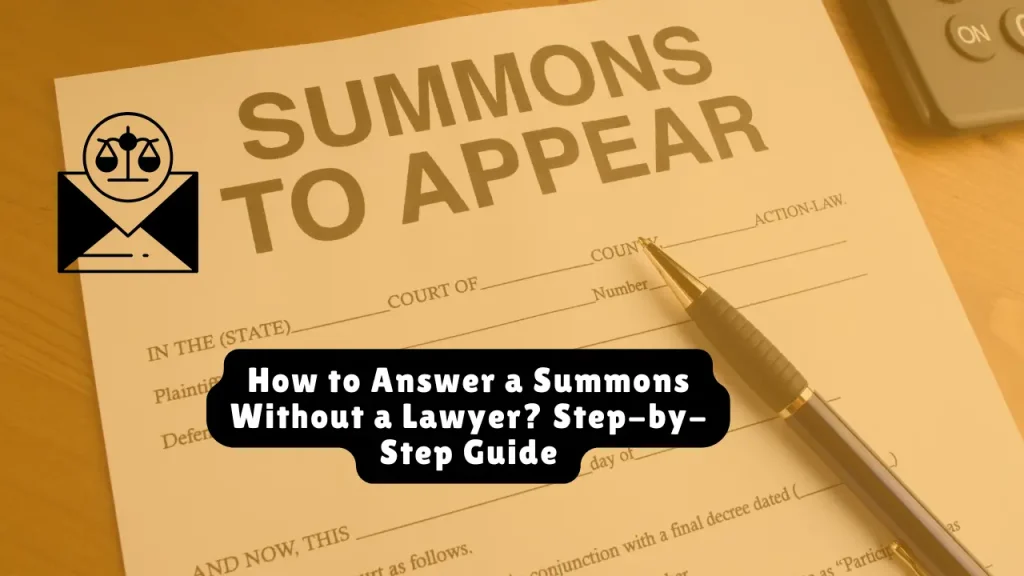How to Answer a Summons Without a Lawyer? Step-by-Step Guide
Receiving a court summons can be intimidating—especially if you’re not represented by an attorney. But whether you’re sued over unpaid debts, contract disputes, or other civil matters, responding properly can protect you from default judgment, wage garnishment, and property liens. This guide breaks down how to answer a summons without a lawyer, whether in general civil litigation or specifically in debt collection cases.
Table of Contents
1. Why Responding Matters
Failing to respond to a summons is legally equivalent to surrendering. If you do nothing, the plaintiff (often a debt collector) can win by default—allowing them to garnish wages, seize bank funds, or place liens on property. Answering the complaint preserves your legal rights and forces the plaintiff to prove their claims in court.
2. Understand the Summons and Complaint
You’ll typically receive two documents:
- Summons: Lists the court, parties involved, and your deadline to respond (typically 20–30 days depending on jurisdiction).
- Complaint: Lists the plaintiff’s claims—e.g., how much you allegedly owe and why.
Debt case tip: Scrutinize the complaint for technical flaws such as:
- Missing or incorrect account numbers
- No proof of debt ownership (debt buyers must show a chain of title)
- Claims involving time-barred debts (check statute of limitations by state)
| State | Credit Card SOL | Mortgage SOL |
| California | 4 years | 6 years |
| Texas | 4 years | 4 years |
| New York | 6 years | 6 years |
3. Know Your Deadline: It’s Non-Negotiable
Your response window varies based on jurisdiction and method of service:
- Federal Court: 21 days (or 60 days if you waived service) under FRCP 12.
- State Courts: Typically 20–30 days. For example:
- NY, TX, GA, FL: 20 days
- CA, IL, OH, PA: 30 days
- NY, TX, GA, FL: 20 days
Pro Tip: If the deadline lands on a weekend or holiday, file the next business day. Use a digital calendar or app to track all critical dates.
4. Drafting Your Answer
4.1 Format the Document
Include:
- Court name and address
- Case number
- Title: “Answer to Complaint” or “Answer of [Your Full Name]”
- Numbered paragraphs that match the plaintiff’s complaint
4.2 Respond to Each Allegation
For every paragraph in the complaint:
- Admit if it’s true
- Deny if it’s false
- State lack of knowledge if you’re unsure (legally treated as denial)
Example:
markdown
CopyEdit
1. Defendant denies the allegations in paragraph 1.
2. Defendant lacks sufficient knowledge to admit or deny paragraph 2.
4.3 Insert Affirmative Defenses
These are legal reasons why the case should be dismissed, even if the allegations are true.
Common defenses include:
- Statute of Limitations has expired
- Lack of Standing (plaintiff has no proof they own the debt)
- Improper Service of Process
- Incorrect Amount Claimed
- Failure to State a Claim
- Lack of Jurisdiction or Venue
Important: Defenses not raised in your Answer may be permanently waived.
4.4 Optional: Add Counterclaims
If the plaintiff owes you money or violated laws (e.g., FDCPA violations), you can countersue. Use clear, numbered paragraphs similar to the complaint’s format.
Related article: California Debt Collection Laws & Statutes of Limitations

5. Finalize with Signature and Verification
- Sign and date the Answer.
- Include a statement verifying the contents are true, often under penalty of perjury.
- Some states or courts may require notarization or a “Verification” section.
6. File and Serve the Answer
6.1 Filing
- Make three copies: One for the court, one for the plaintiff, and one for your records.
- File at the courthouse listed on your summons or e-file if available.
- Filing fees vary ($0–$400); request a fee waiver if low-income.
6.2 Serving the Plaintiff
- Mail a copy to the plaintiff’s lawyer via certified mail with return receipt.
- Anyone 18 or older (not you) may serve the document.
- Complete and file a Certificate or Proof of Service with the court.
7. Post-Filing Strategy: Pressure the Plaintiff
After filing your Answer, use legal tools to pressure the debt collector into dropping the case:
A. Demand Debt Validation
Require the creditor to produce:
- Original signed contract
- Complete payment history
- Documentation showing they own the debt
Stat: 34% of cases are dismissed when creditors can’t produce valid proof.
B. Send Discovery Requests
Force them to prove their claim with:
- Interrogatories (written questions)
- Requests for Documents (e.g., original contract)
C. Negotiate a Settlement
Once you’ve responded and demonstrated you’re serious:
- Offer a lump-sum payment (30–40%) in exchange for dismissal with prejudice.
- Get all agreements in writing—never pay without a signed settlement agreement.
8. Avoid These Common Mistakes
| Mistake | Consequence |
| Ignoring summons | Automatic loss, default judgment |
| Admitting partial debt | May reset statute of limitations |
| Missing deadlines | Judgment without your input |
| Paying without dismissal | No legal protection |
| Using regular mail for service | Risk of rejection by court |
9. Amending Your Answer (if needed)
Under FRCP 15, you can amend your Answer:
- Once without permission if it’s before the court sets a trial schedule.
- Later, only with the court’s permission.
Update if you discover new defenses or facts.
10. Templates and Tools
- Federal Pro Se Sample Answer – uscourts.gov
- Debt Collection Answer Template (with affirmative defenses and relief requests)
- Certificate of Service Template – “I certify I mailed this to Plaintiff’s attorney on [date] by certified mail.”
| State | Answer Form | Fee Waiver |
| CA | PLD-C-010 | FW-001 |
| NY | EF-1 (Consumer) | IFP App |
| TX | General Answer | Affidavit of Indigence |
| FL | Answer Form | Indigency App |
11. When You Might Need a Lawyer
Consider professional help if:
- Debt exceeds $10,000
- You face property seizure or garnishment
- Plaintiff violated consumer protection laws (e.g., FDCPA)
Free or Low-Cost Legal Help:
- Legal Aid Clinics – LawHelp.org
- Pro Bono Programs
- Upsolve and SoloSuit – Assist with document generation and review
Conclusion: You Can Win Without a Lawyer
80% of debt lawsuits end in default judgment because defendants fail to respond. By submitting a timely, well-drafted Answer, you assert your rights, buy time, and force the plaintiff to prove their case. Whether your goal is to dismiss the case, negotiate a lower settlement, or fight the debt entirely—your response is your strongest weapon.
“The pen is your sword. Default judgments fund this industry—your response breaks their business model.” — National Consumer Law Center
About the Author

Sarah Klein, JD, is a former consumer rights attorney who spent years helping clients with issues like unfair billing, product disputes, and debt collection practices. At All About Lawyer, she simplifies consumer protection laws so readers can defend their rights and resolve problems with confidence.
Read more about Sarah
